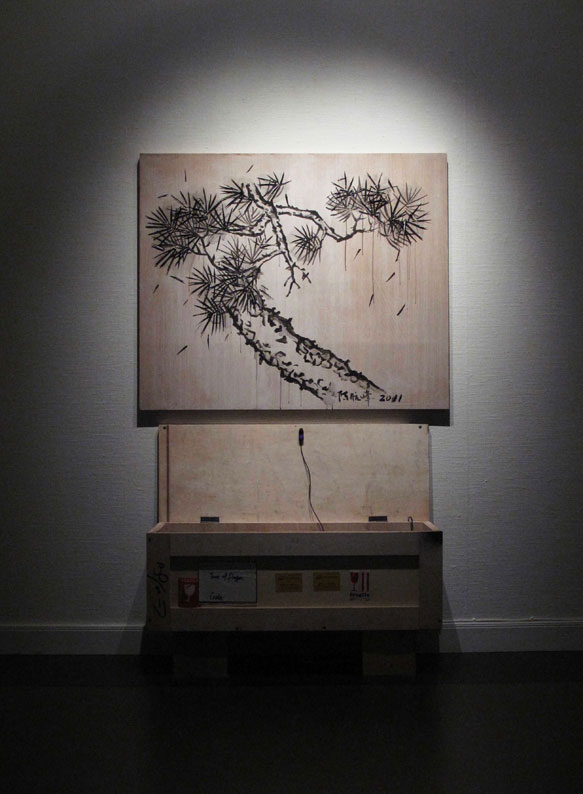Don’t Move
Drawing+Installation: Ink painting, cutted plastic bag, common pin, wood broad, fan, sensor, timer and transformer
Painting: 120 x 100 x 4 cm, installation: dimension variable
2011
Chen Hangfeng takes a great interest in all facets of Chinese traditional culture – and much of his work explores how historical art forms and ideas overlap with and are obscured by contemporary society. In “Don’t Move,” he explores the museumification of traditional culture ¬– which has become more of a specimen of observation rather than a living, breathing part of contemporary Chinese culture. The title of his work reads like an admonishment, similar to that of a museum guard asking some- one to “step away from the art,” and hints at the tension between the viewer and the oftentimes very valuable artwork.
The piece consists of a wooden board, on which is painted a traditional ink painting of a pine tree. The needles of the pine tree are actually small slivers of black plastic cut from plastic shopping bags which are then pinned to the board. The pins make visual reference to the kind of straight pins used to affix insects and other specimens in a display case and create a sense of visual suspense. When the viewer comes close to the work, a motion sensor sets a number of fans into action, causing the plastic pine needles to rustle in the wind.
In this way, we see that Chinese traditional culture can only come alive when we engage with it – read the classics, study poems or practice calligraphy. Without the presence of our gaze it becomes lifeless and still. Although the pursuit of Chinese traditional culture has become a major goal of the Chinese government as part of its soft power initiative, there is often only a selective or surface level understanding of tradition as few have the patience to dig deep into the philosophies and ideas within Buddhism, Daoism and Confucianism – perhaps they are afraid of what they might find. This idea of surface
is reflected in the shininess of the glossy plastic bags – empty objects or packaging which may be attractive on the outside but offer little of substance. We also see reference to this amateur understanding of traditional culture in the brushstrokes – while in certain areas of the painting we can see the controlled disciplined hand of the artist, in others we see insidious drips of paint coming out of the pine branches. These gray meandering drips and the scattering of falling needles add a layer of absurdity, as if the tree is weeping over the loss of something which can never be recovered. (by Rebecca Catching)


